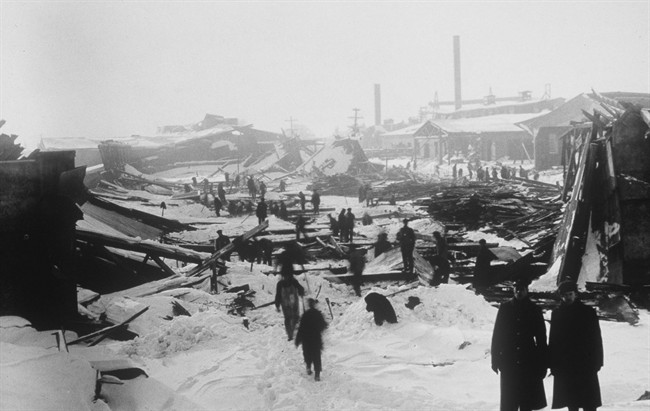Experts are gathering Wednesday for discussions that include a little-known aftereffect of the disastrous Halifax Explosion – it sparked a burst of health reforms that saved many hundreds of lives.

Historian David Sutherland said Halifax saw a flurry of activity to reduce infant mortality, eradicate tuberculosis and bring basic sanitation in “an initial euphoria that we are going to re-invent the city.”
READ MORE: Halifax to install markers commemorating 100th anniversary of Halifax Explosion
He is among the panellists gathering at Dalhousie University to discuss the social changes brought about by the eruption of a burning munitions ship that flattened much of the city’s north end and killed or injured close to a fifth of its population on Dec. 6, 1917.
Sutherland’s new book, We Harbor No Evil Design (University of Toronto Press), describes the array of relief efforts in the city after the Explosion.
Michelle Hebert Boyd, who documented the shifts in social work and public health in her book Enriched by Catastrophe (Fernwood Publishing), said the tragedy brought pasteurization of milk, water treatment, and a health centre that was “the envy of the public health world.”
“After the explosion it was seen as an opportunity to rebuild and to rebuild in a better way,” she said in an interview.
As her 2007 book notes, “Halifax’s inadequate infrastructure made the entire city deserving of the title ‘Dear, dirty old Halifax,’ regardless of where one lived. Prior to the Explosion, many well-off and poorer neighbourhoods shared in common their unpaved streets, open sewers, and dodgy public utilities.”
WATCH: Last Halifax explosion survivor dies
Though the fourth-largest city in the country at the time, Halifax’s tax base was declining and by the beginning of the First World War, sewage still flowed in some streets, Hebert Boyd wrote.
This changed after the Explosion that killed almost 2,000, injured 9,000, blinded 200 and left 25,000 homeless, as philanthropists and governments poured millions of dollars in relief into restoration and relief effort.

Get breaking National news
Initially, large numbers of people initially crowded into small, temporary buildings, and the spread of diseases such as the Spanish influenza epidemic of 1919 and stillbirths related to syphilis grew at an alarming pace.
The Rockefeller Foundation, a charity that promoted public health, approached the Massachusetts-Halifax Relief Committee and sent experts to study how to bring the city a modern public health system.
READ MORE: City seeks living survivors of the Halifax Explosion
By April 30, 1925, the health commission concluded, “while all the improvement may not have been due to the efforts of the Commission, it may justly claim the major share … the drop in mortality … means approximately a saving of 480 lives annually.”
However, historians are still discussing how evenly the benefits of the social and health reforms were distributed.
Hebert Boyd says her research indicated a member of city council successfully lobbied to have a health clinic created by the commission shifted shifted to Dalhousie University, in a wealthier part of the city.
“It was harder for people in the north end to access the care they needed,” she said. “Things earmarked to help people hurt by the explosion was quietly taken away from them.”
On the other hand, Sutherland notes the centre at Dalhousie University continued to provide good care, and he says he “suspects” many people harmed in the Explosion continued to use it.
However, Hebert Boyd says an opportunity to bring improvements to the impoverished black community of Africville was missed in the aftermath.
WATCH: New time capsule in the works for Halifax Explosion anniversary

“While Richmond was being reconstructed and improved after the Explosion, the main sewer line was brought directly through Africville to empty into Bedford Basin; Africville residents were not themselves given sewer service, and to add insult to injury, they had to endure raw sewage from their Richmond neighbours running through their backyards whenever a line broke,” she wrote in her book.
Sutherland says the initial enthusiasm for a remaking of the city decreased in the mid 1920s, amidst a general economic decline that worsened in the Great Depression.
For example, by the Second World War, the city was still experiencing a preventable outburst of diphtheria, and a university faculty to train social workers wasn’t established until the 1940s, he said.
READ MORE: In footsteps of the dead: Remembering the Halifax Explosion through its stories
“There’s a lapse in the early 1920s, and then continuing for two generations and instead of optimism and high expectations, there’s a shift to more pessimistic disillusionment,” he said in an interview.
“The notion that we will emancipate those on the margins, that certainly does not happen.”
Still, some basic changes in health care endured and were built upon, says Gloria Stephens, a retired registered nurse who was also scheduled to speak on Wednesday.
The president of the Nursing History Nova Scotia Society says a fresh focus on treating children led to the creation of a designated maternity hospital.
“You may say the Grace Maternity Hospital was birthed from the Halifax Explosion and they started a school of nurses who specialized in maternity care, so that was the first type of nurses being designated to a specific area,” she said.







Comments